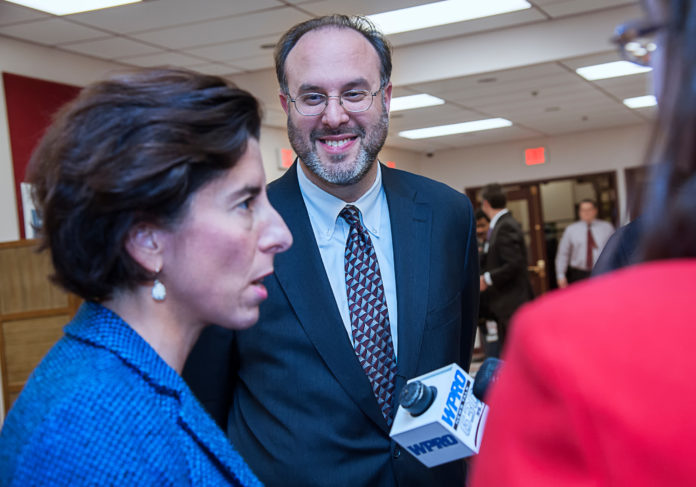
(Updated, 5:40 p.m.)
PROVIDENCE – A package of economic development incentives proposed in the budget of Gov. Gina M. Raimondo will head to the House floor on Tuesday largely intact, with only selected modifications made by lawmakers.
The House version of the fiscal 2016 budget, approved this week by its finance committee, includes a series of targeted programs that will provide loans, grants, tax credits or other incentives for companies willing to create new full-time jobs, redevelop historic structures, attract customers or supply companies to the state, as well as expand or build new facilities.
Altogether, the House budget proposes $44.5 million in economic incentives for the fiscal year that begins in July, to be administered through the state’s Office of Commerce, according to an overview. The total Commerce budget of $76.2 million includes efforts to promote state tourism and spur economic development.
In a statement, Commerce Secretary Stefan Pryor said the Finance Committee had presented a budget with “powerful tools that will help create job opportunities for Rhode Islanders. This is a splendid start and as a result of these investments, we will accomplish a lot together.”
In a statement, Laurie White, president of the Greater Providence Chamber of Commerce, praised the budget package as “pro-business.” The budget approved by the House Finance Committee sends a clear message that the state is serious about bolstering our competitiveness, creating jobs and expanding opportunities for Rhode Islanders,” she wrote.
The largest incentive pool is available for companies that locate in the former Interstate 195 lands. The redevelopment district will have a dedicated $25 million state fund, which will be directed to an “anchor institution” or other catalytic projects that locate on the 195 lands or adjacent parcels.
The funds can be used for purposes including land acquisition and development, and the qualified zone extends one-quarter mile beyond the I-195 district borders. The incentive funds would be directed at the request of the I-195 Redevelopment District Commission, but would also require approval from the commerce secretary.
Another incentive program, Rebuild Rhode Island, is intended to help bridge the financial feasibility gap that developers say is a hindrance to statewide development, because of high commercial tax rates and construction costs that are comparable to cities that command higher rents. The program will receive an initial appropriation of $2 million this coming year, under the House bill, with the goal of providing $60 million over the next five years.
The program would provide developers who create at least 25 full-time jobs with tax credits for five years, worth up to 30 percent of a project cost. The program also could apply to developments of multi-family housing, including in historic structures, which create at least 20 units. The tax credits, which could be sold by the developers, would be redeemable on completion of projects.
The most notable change in the tax credit program made by the House finance committee was to limit the amount that any single project could obtain to $15 million, including all phases of development, according to Rep. Raymond E. Gallison, Jr., committee chairman.
Other statewide development incentives that made it into the budget include:
- The Anchor Institution Tax Credit program, which would provide financial incentives to companies that can demonstrate they brought about the relocation of a supplier or customer to Rhode Island that results in at least 10 jobs. The tax credit would be based on the number of jobs created, the type of jobs and compensation. The program is slotted to receive $1.75 million in fiscal 2016.
- Any project that receives state incentives only has to comply with state building and fire codes, and the inspections can be handled exclusively by state inspectors, rather than local or city agents.
- A new statewide Tax Increment Financing program, which would redirect up to 75 percent of new state revenues in identified zones to new development in that area, or redevelopment projects. This program would apply to developers who want to rehab structures or improve commercial, industrial or residential properties. It includes language that, although not identifying it by name, could include the area around McCoy Stadium in Pawtucket.
- A fund that would provide partial reimbursement to cities or communities that delay real estate or personal property taxes through Tax Stabilization Agreements, providing up to 10 percent back. Projects that qualify would have to create at least 50 new full-time jobs, and cost at least $10 million.
- A $5 million appropriation for the First Wave Closing Fund, which would provide “lynchpin financing unavailable from other sources” for projects that are of a critical nature. The decision to approve either a loan or a grant would be made based on the nature of the project, its strategic importance, and the quality and number of jobs produced, among other factors.
- A jobs incentive program that would provide tax credits for companies for up to 10 years that create new jobs in Rhode Island. The number of jobs required would vary by the size of the business and whether it is in a targeted industry. The proposed credit would reach up to $7,500 per new job created.
For small businesses, several initiatives have remained intact. They include: - A small business assistance program, stocked with a $5.5 million appropriation, which would create a capital access fund. The R.I. Commerce Corporation would partner with lending institutions, and create a number of loan programs, including for direct lending, and provide technical assistance for small companies. Ten percent of the program funds would be “micro-loans” of $2,000 to $25,000, to be administered through lending institutions.
- A $500,000 budget for the Innovation Initiative, which will allow small businesses to use state vouchers to purchase research and development support through non-profit organizations and universities in the state. These would be grants, not loans, and would follow criteria set up by the Commerce Corp.
- Industry cluster grants, to be awarded on a competitive basis, to support activities within industry clusters, or groups of businesses, that would either advance innovation or increase profitability. The grants would be from $75,000 to $250,000.
- Larger grants, of $100,000 to $500,000, would be made available on a competitive basis to identified clusters that have documented constraints on growth.












